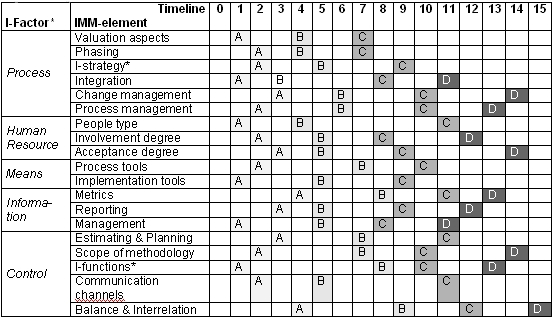Implementation maturity model assessment
This model consists of two important components, namely the: The IMM adopts the five maturity levels from the CMM.
Organizational processes and goals are not considered centrally during implementation projects and communication hardly takes place.
The overall implementation lacks structure and control and its efficiency depends on individual skills, knowledge and motivation.
Project standards are documented per aspect and the organization prevents any deviant behavior or actions.
Each project will be preceded by preparations to assure conformity with the processes and goals within the organization.
Implementing becomes predictable and the organization is able to develop rules and conditions regarding the quality of the products and processes (performance management).
The organization possesses the means to detect weaknesses and to strengthen the implementation process proactively.
By looking at relevant documentation and carrying out interviews, an organization can assess the current status of the elements and hence determine on which maturity levels they are.
Besides giving a complete status overview of the implementation processes within an organization, it is also a good means for communication.
Although these empty cells don't have particular meanings, they do illustrate the dependencies between elements and their maturity levels.
To clarify the activities and concepts of the process-data diagram elaborated so far, two tables containing the definitions and explanations are included below.
Table 2: Concept definition list of meta-data model Table 3: Activities and sub-activities in the maturity assessment process This section contains a fictive case study, written by the author of this entry, to illustrate the application of the IMM assessment.
It involves an IT-organization named ManTech, which focuses on helping companies with implementation projects.
In order to find out on which level they are with their implementation processes, they have decided to use the IMM to guide their assessment.
From the analysis, the following things were found: Unfortunately, due to the lack of documentation, the managers were not able to find all the needed information to valuate all IMM-elements.
Just when the CEO wanted to derive the overall maturity from the matrix, one of the managers suddenly reminded him of the dependencies and checkpoints that needed to be considered.
After some additional analysis, they found among others the following dependencies and checkpoints that might affect the maturity levels of the initial find (see Table 4).
The second step was to improve the elements ‘implementation strategy’ and ‘communication channels’ so that they at least achieve level A.
For ‘communication channels’ to achieve level A, the way with which ManTech selects people to form project teams has to be improved first.


*: ‘I’ is the abbreviation of ‘implementation’

*: ‘I’ is the abbreviation of ‘Implementation’

*: ‘I’ is the abbreviation of ‘Implementation’